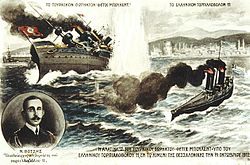- Ottoman ironclad Feth-i Bülend
-

Illustration of the sinking of Feth-i-BulendCareer (Ottoman Empire) 
Name: Feth-i Bülend Builder: Thames Iron Works, London Laid down: May 1868 Launched: 1869 Commissioned: 1870 Fate: Hulk in 1910, sunk by Greek torpedo boat in 1912 General characteristics Type: Armored corvette Displacement: 2,762 tonnes (2,718 long tons) Length: 71.6 m (234 ft 11 in) (p.p.) Beam: 11.9 m (39 ft 1 in) Draft: 5.2 m (17 ft 1 in) Installed power: 3,250 ihp (2,420 kW) Propulsion: 1 shaft, horizontal compound expansion steam engine
6 box-type (1870), 2-cyl. water-tube type (1906)Sail plan: Brig-rigged Speed: 13 knots (24 km/h; 15 mph) during trials, 9 knots (17 km/h; 10 mph) in 1906 Range: 1,500 nmi (2,800 km; 1,700 mi) at 10 kn (19 km/h; 12 mph) Complement: 16 officers, 153 sailors
(total 150 by 1912)Armament: Original: 4 × 222 mm
Additions 1882/1890: 1 × 170 mm (1882–1890), 2 × 87 mm (1882), 2 × 63 mm (1890), 2 × 37 mm (1890), 1 × 25.4 mm (1890)
1906 configuration: 4 × 150 mm L/40, 6 × 75 mm, 6 × 57 mmArmour: Belt: 102–230 mm (4–9 in)
Battery: 203–254 mm (8–10 in)
Bulkheads: 140 mm (5.5 in)Feth-i Bülend ("Great Causer of Conquest") was an Ottoman ironclad warship. At the time of its commissioning in 1870, it was one of the more advanced, compact, and heavily-armed ironclads of the world. It was armed with four 229 millimeter (9 in) guns, was powered by a single-screw compound engine, but could also run on sail if the weather was right. It served until 1910, when it was laid up as a hulk in the harbour of Thessaloniki, where it was sunk during the First Balkan War by a Greek torpedo boat.
Contents
Construction
Feth-i Bülend was constructed as part of an attempt to modernize of the Ottoman Navy. In a bid to support the backward Ottoman Empire against Russian expansionist policies, Great Britain gave considerable aid to the Ottoman Empire in their efforts to build a powerful and modern naval fleet. In the 1860s and 1870s, so many modern ironclad warships were built on behalf of the Ottoman Empire by both France and Great Britain that the Ottoman Empire became the world's third largest naval fleet. Much of this development occurred under the administration of a British naval officer, Hobart Pasha.
The Feth-i Bülend was a casemate ironclad, central battery ship. It was ordered in 1867 and built at Thames Iron Works, Blackwall Yard in London in 1868–1870, being commissioned in 1870. After suffering damages against the Russians in 1877, it was laid up and refitted in the Ottoman arsenal at Constantinople in 1890.[1] It was stripped of its armament in 1898, and again reconstructed and updated at the Ansaldo Italian Shipyards between 1903 and 1907.[2]
Service history
Feth-i Bülend saw extensive service in the Black Sea during the Russo-Turkish War of 1877–1878. She took part in the bombardment of Russian positions and capture of the Black Sea port of Sokhumi on 14–16 May 1877. On 23 July, she exchanged fire with the Russian armed steamer Vesta, suffering minor damage, while on 25 August, it encountered the Russian yacht Livadia, which was able to break contact before action could commence.[3]
At the outbreak of the Italo-Turkish War of 1911–1912, Feth-i Bülend was disarmed, and its armament used to bolster the defenses of Thessaloniki's harbour, manned by 90 of the ship's crew. The ship itself was converted to an accommodation hulk.[4] At the time of the outbreak of the First Balkan War on 18 October 1912, the ship's commander was Captain (Binbaşi) Aziz Mahmut Bey, who also functioned as naval garrison commander. On the night of 31 October [O.S. 18 October] 1912, the Greek torpedo boat No.11 commanded by Lt Nikolaos Votsis passed by the shore batteries and searchlights, through the mine barrages and launched three torpedoes at 23:30 against the Feth-i Bülend. One torpedo missed, hitting the quay, but the two others hit the ship, capsizing the ship. Seven of its crew, including the ship's imam, were lost, while the Greek vessel exited the harbour by the same route without further incident.[5]
References
Sources
- Gardiner, Robert, ed (1979). Conway's All the World's Fighting Ships 1860-1905. Greenwich: Conway Maritime Press. ISBN 0-8317-0302-4.
- Langensiepen, Bernd; Güleryüz, Ahmet (1995). The Ottoman Steam Navy, 1828–1923. Conway Maritime Press. ISBN 0-85177-610-8.
- Silverstone, Paul H. (1984). Directory of the World's Capital Ships. New York: Hippocrene Books. ISBN 0-88254-979-0.
External links
Categories:- 1869 ships
- Leamouth-built ships
- Naval ships of the Ottoman Empire in the Balkan Wars
- Shipwrecks in the Aegean Sea
- Maritime incidents in 1912
- Ironclad ships of the Ottoman Navy
Wikimedia Foundation. 2010.
